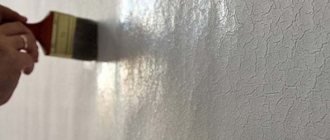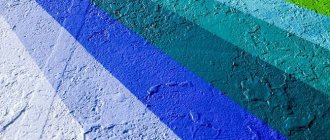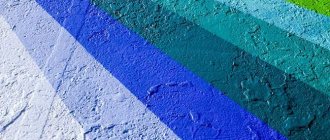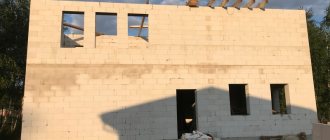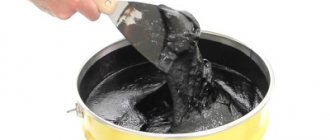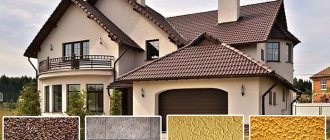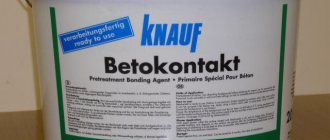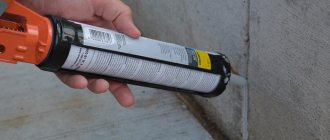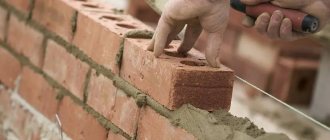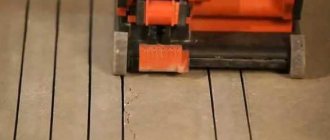To level surfaces and give them an aesthetic appearance, concrete putty is used for interior work. There are always increased requirements for this material, since it is used for finishing work. The solution creates a durable surface, has waterproofing properties, is not afraid of sub-zero temperatures, and does not shrink.
Putty is a composition necessary to level the surface before finishing or applying materials on top.
Types of putty
Putty is a thick mass consisting of binding elements that, after hardening, form a durable surface. The main purpose of façade putty is to level out defects and fill small voids to create a smooth surface.
The putty is sold in the form of a dry and ready-mixed mixture. The disadvantage of the ready-made putty mixture is its limited shelf life and rapid hardening.
Depending on the purpose, putty is made from various materials:
- Cement based;
- Gypsum based;
- Acrylic;
- Latex;
- Oil glue.
When plastering, the following types of facade putty are used:
- Mineral;
- Acrylic;
- Silicate;
- Silicone.
Waterproof facade putty - designed to create a protective and decorative layer. Materials for the exterior decoration of buildings must have a certain list of properties.
Putty makes the surface strong, durable, resistant to seasonal temperature changes and precipitation.
An important role is played by a high level of adhesion, that is, the ability to stick to any material. Compatibility with any paint and varnish materials is a prerequisite when choosing a putty.
Due to the large surface area to be treated, preference is given to dry mixtures, which are mixed with water until the finished mass is obtained. According to reviews, cement-based façade putty is popular.
Requirements for compositions
Concrete structures are often operated under conditions of multiple environmental influences. Mechanical loads, humidity, aggressive chemical environments, wind, temperature changes - all these factors in themselves can lead to the gradual destruction of the material. Therefore, the putty should be such as to protect (create a barrier) the material from the external environment to the maximum extent possible. In addition, puttying should improve the adhesive properties of the surface, because often concrete structures are subject to further finishing work.
So, a good putty should be characterized by the following qualities:
- durability of the coating (resistance to friction and other mechanical loads),
- reliable adhesion,
- moisture-proof qualities,
- fire safety,
- non-toxic,
- resistance to chemicals,
- resistance to low and high temperatures, as well as sudden temperature changes,
- long service life.
Concrete compositions also have disadvantages:
- It is impossible to glue concrete covering layers to the substrate.
- Not all defects can be removed - we are talking only about small irregularities.
- The job requires some experience.
- In case of flooding, the moisture resistance of the coating will still not be enough.
When choosing putties, it is recommended to pay attention to the following qualities:
- adhesion,
- purpose of a specific composition (is it suitable for concrete),
- percentage of moisture resistance,
- vapor permeability (will the coating allow moisture to circulate).
Cement-based putty
Cement putty for facades is an excellent option for treating the front surface of a house. It comes in the form of a dry mixture consisting of cement, sand and some binders. The cement contained in the putty gives the surface high strength and resistance to moisture.
One of the most popular in the construction environment is Knauf facade putty. There are two types of cement putties:
- Basic;
- Finish.
Basic façade putty is usually applied in a thick layer up to 1.5 cm and serves as a filler for large cracks and irregularities.
The finishing façade putty has a delicate composition and, after drying, creates a smooth and even surface. The use of cement putty for facade work should be carried out at a temperature not lower than +5 degrees and a humidity of 80%.
The finished mixture cannot be mixed with paints, glue or other substances; it may lose its properties, which means the quality of work will be low.
Both amateurs and professionals note that cement putty is one of the most popular finishing materials for facades in terms of price and quality of coating.
Characteristics and purpose
Putty is a composition that is a thick paste-like mixture or powder intended for leveling surfaces. There are putties for different types of surfaces, including separately for concrete.
Thanks to putty, a durable and even coating with good adhesion is formed on the surface, making it possible to further finish the base, for example, glue wallpaper or apply paint.
The putty contains a filler and a thickener. The filler consists of barite, talc and chalk. In addition, the composition may contain pigmenting substances, including ocher and zinc white. Both of these pigments act as an addition to the film-forming substance.
Areas of application of putty compositions:
- restoration work on concrete and reinforced concrete structures that have fallen into disrepair over time,
- standard work on leveling concrete bases before laying waterproofing materials or applying finishing,
- leveling of defects existing in crushed stone nests and seams,
- processing of concrete in tunnels, trenches, viaducts, on railway tracks.
In other words, wherever there is concrete, you can’t do without putties.
Polymer putty
Polymer putties appeared in construction relatively recently. They are very convenient and can be stored diluted for up to 12 hours. Long-term freezing makes it very easy to use.
All polymer masses can be divided into two groups:
- Acrylic;
- Latex.
Acrylic putty
The surface of acrylic putty is highly durable and retains its properties even with large changes in temperature and humidity.
This material is very flexible and does not peel off.
- Apply a layer no more than 3 mm thick and only on the primed surface.
- A significant disadvantage of acrylic putty is its high cost, as well as its incompatibility with wood and metal surfaces.
- If there are deep irregularities, it is necessary to apply acrylic putty in several layers.
Latex putty
Supplied as a paste, ready to use. Depending on the purpose, there are two types: for leveling the surface and finishing. Suitable for application to any surface, including wood and metal. The prepared surface must be primed.
- Latex putty can be diluted with water, but not more than 1% by weight.
- You can only work at temperatures above +5 degrees.
- The mixture is resistant to temperature changes, the coating remains durable and does not deform.
A variety of colors will save on painting costs. The delicate composition of latex putty will give the wall an elegant look and the surface does not require additional treatment.
Preparation of putty
Each manufacturer provides detailed instructions on how to prepare the mixture for dry mixing. The proportions are indicated on the packaging.
Mixing the mass is carried out using a special mixing attachment on a drill.
- After kneading, the mixture should be left for 10-15 minutes and mixed thoroughly.
- You should not prepare a lot of solution at once; it may dry out and will not be homogeneous.
- The finished façade mass must be used within 20 minutes.
Homemade putty recipe
Facade putty for exterior use can be made with your own hands. Homemade putty is often used by experienced plasterers.
- You only need cement and sand mixed in a 1:4 ratio.
- The sand must be clean, sifted, without lumps of clay and stones.
- First mix the dry mixture and then add water. For light putty it is better to use white cement.
- This mixture is suitable for applying a base layer, and after drying it must be covered with a finishing layer.
Manufacturers
The best putty manufacturers offer high quality products. TOP 5 best façade putties according to the 2020 rating:
- Ctresit CT 29 - considered the best manufacturer of facade putty;
- Perel TeploRob - has a high level of thermal insulation;
- Dufa Struktur Putz - has the highest quality coating;
- EcoStone Bayramin - recognized as the best plaster with natural stone;
- Found TS117 - a mixture for mineral surfaces.
How to choose?
The rules for selecting, preparing and applying the material can be studied in accordance with GOST R 57984-2017 / EN 13914-1:2005.
View “GOST R 57984—2017/ EN 13914—1:2005” or
For interior work, the putty must be durable and environmentally friendly. If the material is needed for finishing a bathroom, then the putty should be moisture resistant. For exterior work, façade putty is used. The material must be resistant to external influences and have a beautiful aesthetic appearance. It is important to choose proven and reliable companies.
Tools
The most important tool when working with putty is a spatula. It is better to immediately buy a set of different sizes. If you need to putty a large area of the wall, then the spatula should be large, but for hard-to-reach places it is better to use a small one.
Rubber and silicone spatulas are very convenient to use and make it easier to level the surface.
Experienced professionals prefer durable spatulas made of carbon steel, which do not bend even when working with large masses of putty. It is more convenient to use a corner spatula for processing corners.
A few caveats
When working with concrete putties, it is recommended to follow certain rules:
- If the surface is too smooth, it is necessary to give it some roughness. This can be done by creating notches. In some cases, reinforcement is even used.
- It is not allowed to pour putty compounds into the formwork. This will do nothing in terms of the putty fulfilling its intended purpose.
- The mixture contains all the necessary additives, and their presence does not contradict the proximity with other components of the solution. You cannot add additional components (including cement) to the mixture, as this will only worsen the quality of the original.
- If the putty has started to set in the container, there is no point in trying to stop the process by adding water. If time has already been lost, it is better to throw away the batch that has become unusable and make a new batch.
- It is necessary to monitor the air temperature during puttying. The packaging always indicates the minimum ambient temperature at which work is allowed. The typical minimum level is 5 degrees above zero, although there are compounds with a minimum level of 3 degrees Celsius. In this case, the minimum temperature at which the finished surface can be used does not matter (even if we are talking about 40 degrees below zero). It is the minimum indicator when puttying that is important.
